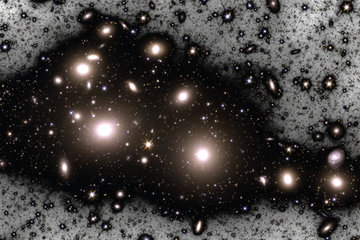Quantum steps towards the Big Bang
A new approach to the unification of general theory of relativity and quantum theory
Present-day physics cannot describe what happened in the Big Bang. Quantum theory and the theory of relativity fail in this almost infinitely dense and hot primal state of the universe. Only an all-encompassing theory of quantum gravity which unifies these two fundamental pillars of physics could provide an insight into how the universe began. Scientists from the Max Planck Institute for Gravitational Physics (Albert Einstein Institute) in Golm/Potsdam and the Perimeter Institute in Canada have made an important discovery along this route. According to their theory, space consists of tiny “building blocks”. Taking this as their starting point, the scientists arrive at one of the most fundamental equations of cosmology, the Friedmann equation, which describes the universe. This shows that quantum mechanics and the theory of relativity really can be unified.

For almost a century, the two major theories of physics have coexisted but have been irreconcilable: while Einstein’s General Theory of Relativity describes gravity and thus the world at large, quantum physics describes the world of atoms and elementary particles. Both theories work extremely well within their own boundaries; however, they break down, as currently formulated, in certain extreme regions, at extremely tiny distances, the so-called Planck scale, for example. Space and time thus have no meaning in black holes or, most notably, during the Big Bang.
Daniele Oriti from the Albert Einstein Institute uses a fluid to illustrate this situation: “We can describe the behaviour of flowing water with the long-known classical theory of hydrodynamics. But if we advance to smaller and smaller scales and eventually come across individual atoms, it no longer applies. Then we need quantum physics.” Just as a liquid consists of atoms, Oriti imagines space to be made up of tiny cells or “atoms of space”, and a new theory is required to describe them: quantum gravity.
Continuous space is broken down into elementary cells
In Einstein’s relativity theory, space is a continuum. Oriti now breaks down this space into tiny elementary cells and applies the principles of quantum physics to them, thus to space itself and to the theory of relativity describing it. This is the unification idea.
A fundamental problem of all approaches to quantum gravity consists in bridging the huge dimensional scales from the space atoms to the dimensions of the universe. This is where Oriti, his colleague Lorenzo Sindoni and Steffen Gielen, a former postdoc at the AEI who is now a researcher at the Perimeter Institute in Canada, have succeeded. Their approach is based on so-called group field theory. This is closely related to loop quantum gravity, which the AEI has been developing for some time.
The task now consisted in describing how the space of the universe evolves from the elementary cells. Staying with the idea of fluids: How can the hydrodynamics for the flowing water be derived from a theory for the atoms?
This extremely demanding mathematical task recently led to a surprising success. “Under special assumptions, space is created from these building blocks, and evolves like an expanding universe,” explains Oriti. “For the first time, we were thus able to derive the Friedmann equation directly as part of our complete theory of the structure of space,” he adds. This fundamental equation, which describes the expanding universe, was derived by the Russian mathematician Alexander Friedman in the 1920s on the basis of the General Theory of Relativity. The scientists have therefore succeeded in bridging the gap from the microworld to the macroworld, and thus from quantum mechanics to the General Theory of Relativity: they show that space emerges as the condensate of these elementary cells and evolves into a universe which resembles our own.
Quantum gravity could now answer questions regarding the Big Bang
Oriti and his colleagues thus see themselves at the start of a difficult but promising journey. Their current solution is valid only for a homogeneous universe - but our real world is much more complex. It contains inhomogeneities, such as planets, stars and galaxies. The physicists are currently working on including them in their theory.
And they have planned something really big as their ultimate goal. On the one hand, they want to investigate whether it is possible to describe space even during the Big Bang. A few years ago, former AEI researcher Martin Bojowald found clues, as part of a simplified version of loop quantum gravity, that time and space can possibly be traced back through the Big Bang. With their theory, Oriti and his colleagues are hoping to confirm or improve this result.
If it continues to prove successful, the researchers could perhaps use it to explain also the assumed inflationary expansion of the universe shortly after the Big Bang as well, and the nature of the mysterious dark energy. This energy field causes the universe to expand at an ever-increasing rate.
Oriti’s colleague Lorenzo Sindoni therefore adds: “We will only be able to really understand the evolution of the universe when we have a theory of quantum gravity.” The AEI researchers are in good company here: Einstein and his successors, who have been searching for this for almost one hundred years.
TB/PH












